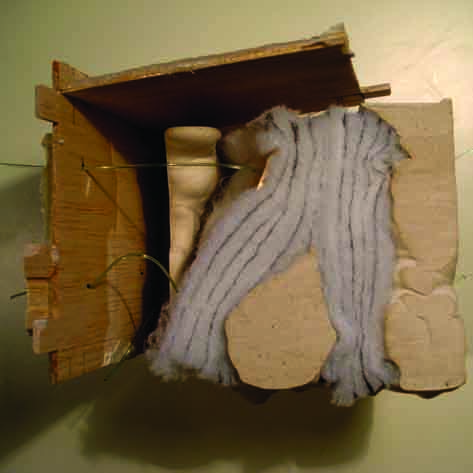

The present thesis forms a «concept of movement» based on the experiential and empiric recording of movement itself. Starting line of our thought (which in fact derives from our research on the movement of body and choreography) is an example of wood frame [xylotypos], that we record as an elementary form of mould. Moreover, on the basis of different each time material, we experiment on mould, as a means of recording altered relations. Furthermore, we receive, as a case of stereotype – mould, the movement itself in the empiric space of our own residence. We process the results as a material that leads to the manufacture of new forms and relations of movement in space. The final architectural example, constructed through the preceded theoretical and experimental procedure, imprints the flow of movement in space and time.
Supervisor: Lykourioti Iris
Reference Number: 227








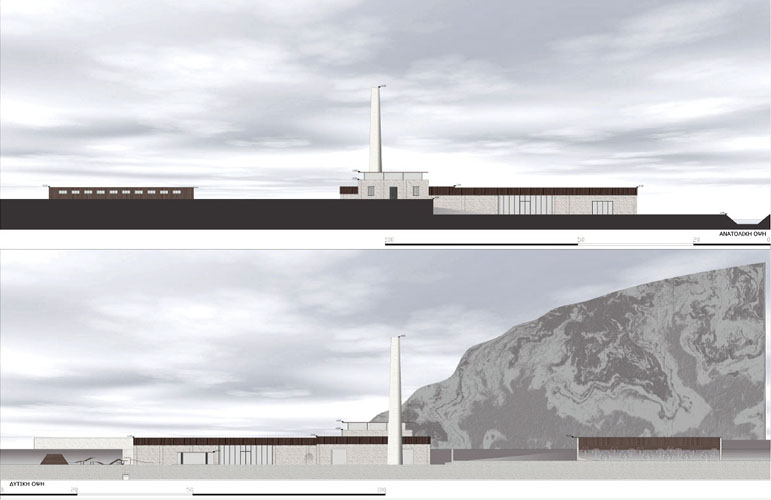



The diplomatic work concerns the study of re-establishment and re-use of the paper’s factory industrial group “Orovie” which is found in the settlement of Rovies in Northern Evia. The paper factory was manufactured in 1908 and up to the dues of decade 1980 are added new buildings. The industrial group includes: the building of paper production, offices, working residences, residence of director of enterprise, stocking spaces, installations of biological cleaning of sewages, jetty charge and discharge of raw material and products, chimney. The total area of buildings of group is 4.270 m2, in plot of 30 acres.
The building phases of group are six: 1908 built the main space of production, the working residences and the residence of director, 1908-1912 were manufactured two small buildings (boiler room and lockers room for workers), 1912 construction of a second floor, a loft, the chimney and also the jetty, 1937 building of offices, in 1970 have the super elevation of floors and manufacture of deposit, dues of decade '80 installations of biological cleaning of sewages.
The buildings of factory as well as the mechanical equipment are saved in very good situation and almost entire. The building of working residences has been destroyed and saved department of northern wall. In bad situation is saved the building of residence of director of enterprise.
The study includes imprinting of group, proposal of maintenance of his first building phase and the re-use.
The news of buildings group will include laboratory of craftsmanship of paper, a small museum, space of lectures, theatre with auxiliary space, stocking space, cafeteria and hostel of total area 4.715 m2.
In the first unit are presented in general elements that concern the settlement of Rovies, elements for the geographic place, the climatic and geomorphologic conditions of region and information for the population.
In the second unit, is presented a short report on the foundation and the operation of paper factory.
The third unit deals with the place, the recognition and the description of buildings of group as well as the building phases of group, that emanated from observation on the spot, written and oral testimonies, photographic material and inset chronologies of construction.
The fourth unit includes the re-establishment of existing group and his adaptation in the new uses as well as the addition of new buildings for the needs of visitors.
Supervisor: Papadopoulos Spiros
Reference Number: 208
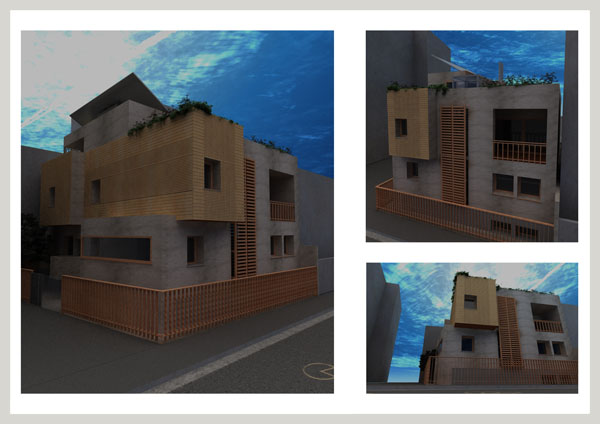

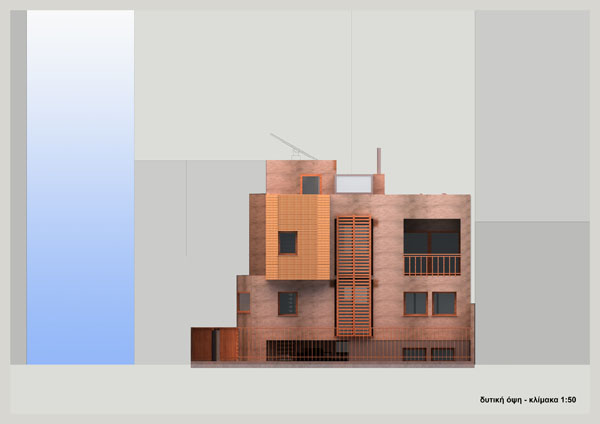

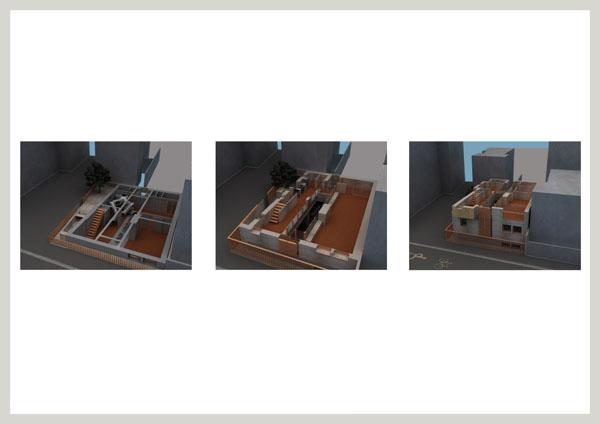







Through the years people were constructing homes, using thermal mass, insulation and light direction for their benefit. After the last half of the 20th century this technical ability was given up having as a result the enclosure of the construction techniques in the service of the economical needs.
Today, as the “environmental future” seems unsure because of the unstoppable use of the limited natural resources and the energetic end, we try to go back to the basic constructional, bioclimatic principles by the creation of new buildings based on bioclimatic principles.
The effects of design outside the principles of bioclimatic and energetic balance, they also add and speed up the negative development of the metabolic. The construction firms, the architects and the owners give a small amount of attention to the design of buildings which embody the basic principles and technology for the right use of the natural resources and the economy of energy.
A different approach, this of “energy efficient housing” can drastically change the weight of the constructional technology for the environmental negative balance.
After careful study for the construction of the building, special attention has to be given to three basic points:
- The way of attaching the house to the environment
- The technical and aesthetic resolution of the thermal comfort parameters for every single chronically period
- The right and technically logical choice of materials.
The other, added parameters of design, as the optical comfort, the waste control and the water circle, change according to the geographical position, the social level and the economical ability of the owners.
The building cost finally, for the bioclimatic house is much higher than a common one, having in mind the obvious economical benefits of the investment through a period of 5 to 20 years.
Design proposal
More specifically the design proposal describes a energy efficient home in the centre of the city of Larissa on an angular space with north-western face. The building is attached on the east and south side to other houses. The house has two floors and a basement with a small room on the roof garden and its total area is 450m². It will house a four member family with artistic and ecological interests. It occupies the biggest part of the space given, and some trees will be planted for shadowing and wind protection.
For the design of the building we adopted the principles of bioclimatic architecture including south facing windows and skylight for direct thermal benefit as also an internal sun space (atrium) which connects to all the levels of the house.
The design goal is to reduce the effects of the local climate, during the summer period as also during the winter. A building in the centre of a big city presents low consuming during the period of high thermal needs because of the design and the embodied pathetic systems, and the users’ behavior.
A characteristic point of the design proposal is the thermal system with the energetic fire place.
The design of interior spaces was completed by emphasizing to specific details of their use. It is obvious the clear subdivision of the building in zones on each level:
Basement - play zone and workshop space
Ground floor – food and relaxing zone
First floor – sleeping zone
Roof terrace – green zone
We achieve to complete high levels of economy for heating, cooling and direct sunlight.
House Construction
The construction of the cell is based on solid walls of 50cm thickness, so that internal air flow is limited as well as the glazed facades which remain sources of thermal losses on the North side of the building.
The constructional proposal includes a construction which adopts the use of ecological materials with important energetic benefits and economy for the construction. The concrete frame of the building is covered by straw bales joined together with a wooden frame.
On the construction techniques we include direct air flow through the building and the atrium.
The owners and future occupants report that the house has to achieve thermal comfort of 19 ˚C. Τhey also reported that bedrooms should achieve high temperatures, which is a fact of the warm air rising up because of the layering.
Supervisors: Stylidis Iordanis, Tsangrassoulis Aris
Reference Number: 210
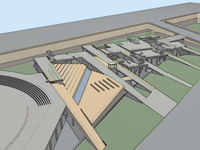

The project focuses on the creation of a public civic space with entertainment infrastructures in relation to historic monuments. It’s located in a part of the moat that surrounds the Venetian walls of the city of Nicosia, next to the D’ Avila bastion.
A short study of the contemporary urban environment in relation to monument-cities is conducted and an attempt is made to connect the two in the “porous border” that is the old city’s moat and which has always been the point where they always collided and
re-united in town planning level, socially and connotatively.
The proposal is based on a mental process and constant re-design of the existing municipal environment, the present circumstances that identify activities or usage, and the intellectual approach to urban space as “public”. By public, we are implying a space where citizens should perceive and obtain as their own, therefore occupy it through interaction.
When designing this public space, elements such as the contemporary city’s network, the limit of the old city’s Venetian walls and flora native to the area, were taken under consideration. This has generated ligaments between the three levels that make up the proposed public space empowering the meaning of an easily accessible communal domain.
The recognition of the memory of space, the osmosis between past, present, future and the understanding of the complexity of a spatial structure belonging to the citizen in such a place of porous nature and multi-dimensional variable elements, creates a living organism which exists as part of the greater urban environment.
Supervisor: Manolidis Kostas
Reference Number: 226






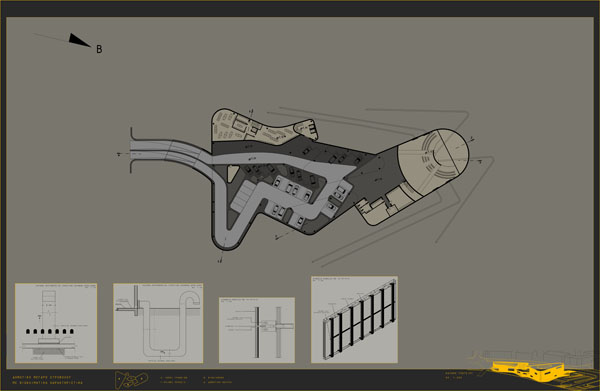





The subject of the Degree Thesis is constituted from an older architectural competition in Cyprus for the construction of Strovolos City Hall.
The particularities of the area, as the bank of the river, the planting as well as the historical old area centre had important effect in the orientation of the subject’s central idea.
The final configuration came from the segregation of the provided services and functions of the City Hall as well as the parameter of bioclimatic design.
The operation’s segregation is inside the single entity that the exterior wrapping provides. The reception constitutes the core of the whole building and it has become different by the skylight on the roof and the absence of wrapping in its entries.
The major bioclimatic parameters were applied to the offices and concern mainly heating, cooling, lighting and airing, to ensured the acceptable indoors conditions at winter-summer period and to limit the energy consumption. Other bioclimatic systems, such as atrium, skylights and buried pipes in the Municipal Theatre, were adopted for more benefits.
Supervisors: Triantafillidis Giorgos, Tsangrassoulis Aris
Reference Number: 206


In an era where architecture, art and advertising discover new bidirectional relations, is rendered essential the collaboration of authors through a wide spectrum of specialities. This project proposes a building-hybrid that results from the coupling of the programms of an advertizing company, an exhibition space, design workshops and amphitheater. The designing and functional questions that were placed by the coupling of programs led to a united confrontation of space internally but also concerning the neighbouring buildings and the overdraft space. The routes that morph and create the united structure of the building, propose a continuous movement aiming at the parallel work and interactivity of the creative teams with the visitors.
In the effort of integration of building in the dense-layout urban web but also in the microcosm of the overdraft spaces and neighbouring buildings, is proposed the placement of building in distance of 3 meters internally from the limits of the plot, while as another network of voids that result from the morphing of volumes create the lame structure of the building in bidirectional viewings between the street, the building and the overdraft space.
The proposal for the creation of a building for accommodation of installations for autonomous creative teams is placed in a empty plot 700sq.m roughly, in Kriezotou str. in the center of Athens. In the ground floor we have the reception and the beginning of the ramp that functions as an exhibition space. In the underground level that can be visited from the central stairwell and the lift, are the amphitheater, the cafeteria and auxiliary spaces. In the first floor and mid -level the ramps lare eading to the basic exhibition space, while also there are cafeteria and auxiliary spaces.In the second level and mid-level are placed one workshop space, rest area, an internal garden and a auxiliary space, while in the third level we have the secretary office ,a second workshop and space of rest and auxiliary space.In the fourth and last level there is the brainstorming room and auxiliary space.
The vertical holder elements constitute pieces of corridors of building, being lame as “wells” they link in level of viewing, support the levels and simultaneously provide natural lighting in the space. The role of this hybrid building in the city is to provide the infrastructure for the operation of creative teams that emanates from a wide spectrum of specialities as architects, artists, advertisers, commercial artists, fashion designers and other that might work collective. Simultaneously the visitor can pass progressively deeper in the operation of the building-program beginning from the exhibition space, continuing in workshops and ending in the brainstorming room, the space of idea-making.The operation of program is founded also the voluntary attendance of visitor lending thus the element of interactivity and attendance.
Supervisor: Papadopoulos Spiros
Reference Number: 212


Nowadays, it is of high importance to control the building rate and protect the coastal places that are threatened from the human presence. For my project I chose the St Nicolas area in Anavyssos of Attica, as it is a place of exquisite beauty threatened by the unorganized building development for touristy purposes. My proposal aims to draw the attention to this area, protect it and contribute to a controlled development.
A tombolo connects the St Nicolas Island with the mainland. In the east of the tombolo, there is a natural gulf with stagnant water where a unique biotope lies within.
To start with, I have drawn a footpath that enters and crosses the pine hill of the mainland and unites the last boarder of Anavyssos with St Nicolas. The route that the walker should follow is not drawn by a continuous footpath but there are some low-height supporting walls that point to the right direction where the footpath is interrupted. A light-weight stand for refreshments is placed at the meeting point of the footpath with the sea water, while nearby the footpath one comes across small gardens with local vegetation as resting stops for the walker.
When the path ends up in the water it converts into a platform (a pier) that connects it with the island. The path continues near the chapel with the small gardens and surrounds the whole island.
Apart from the above, I have placed a small Centre for Marine Research at the top of a hill in the mainland. This centre should address issues relevant to the protection of the local submarine life.
To conclude, my intention is to attract the interest to the beautiful spots of this area which haven't been developed yet, within the concept that mild intervention in the topography and appearance of an area brings people and life closer to nature, while at the same time respecting it.
Supervisor: Kotionis Zissis
Reference Number: 222


The choice of subject emanated from the reflection on the structure of school building in Greece, which constitutes initially a social and then an architectural question. The plot is located in the Municipality Koropi of prefecture Attica. The inclining ground gave us the opportunity to process in step with the planning of the school, the planning of the ground, as well as how this converses with the building. Through this process the relations of interior and exterior space become relations of school building and environment.
The plan also includes special laboratories of positive sciences, a closed gym, accommodation for exchange students and a piazza - exhibition space, which are open for use from the community.
Supervisors: Papadopoulos Spiros, Tzirtzilakis Yorgos
Reference Number: 234

